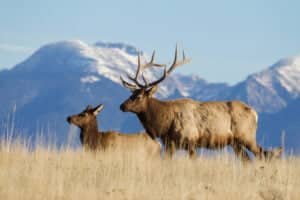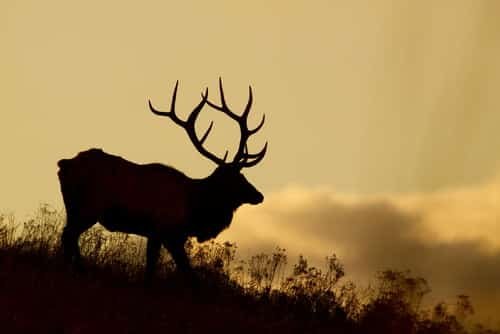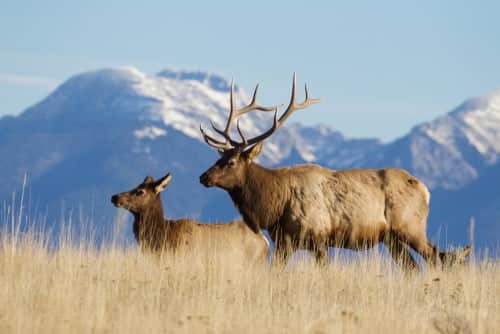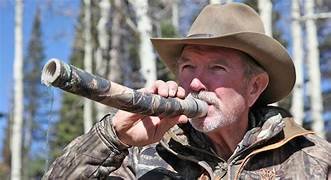Behind the Antlers: The Remarkable World of Female Elk
Elk vs Moose: Within the vast realms of wilderness, two iconic species reign supreme – the majestic elk and the formidable moose. These magnificent creatures have captured the imagination of nature enthusiasts, wildlife lovers, and researchers alike. With their imposing presence and charismatic allure, elk (Cervus canadensis) and moose (Alces alces) stand as living testaments to the grandeur of Mother Nature.
Elk and moose belong to the deer family (Cervidae), yet they exhibit distinct characteristics that set them apart. Understanding these differences is essential for those who embrace a fascination with these extraordinary animals and for biologists, ecologists, and land managers responsible for their conservation.
By delving into their taxonomy, habitat preferences, physical attributes, dietary habits, and conservation status, we can unravel the unique tapestry woven by these species. Exploring the world of elk versus moose offers a profound opportunity to comprehend nature’s intricate design in sculpting diverse life forms.
It allows us to gain insights into evolutionary adaptations forged by millennia of survival strategies in varied landscapes. Moreover, understanding these differences can aid in implementing effective management practices to ensure their long-term coexistence alongside humans in an ever-changing environment.
Taxonomy and Classification – Elk vs Moose
Elk (Cervus canadensis)
The Majestic Cervus Canadensis Elk, scientifically known as Cervus canadensis, belongs to the family Cervidae and is part of Artiodactyla.
Within the species, C. canadensis are several recognized subspecies, each with distinct characteristics and distribution ranges. These include the Rocky Mountain elk (Cervus canadensis nelsoni), found primarily in the mountainous regions of western North America, and the Roosevelt elk (Cervus canadensis roosevelti), which inhabits the coastal areas of the Pacific Northwest.
In terms of distribution, elk are found throughout North America, with populations ranging from Canada to Mexico. However, their specific habitat preferences vary depending on the subspecies.
For example, Rocky Mountain elk thrive in high-altitude environments such as coniferous forests and alpine meadows, while Roosevelt elk prefer dense rainforests along coastal regions. Physically, elk are characterized by their impressive size and stature.

Adult males, known as bulls, reach shoulder heights of around 4-5 feet (1.2-1.5 meters) and weigh between 700 to 1000 pounds (318-454 kilograms). Females or cows are slightly smaller but still exhibit considerable strength and grace.
One notable feature that differentiates elk from other deer species is their antlers. Elk possess large antlers and branching with multiple tines or points extending outwards from a central beam.
Antler size varies among individuals depending on age and overall health but generally spans from 40 to 60 inches (102 to 152 centimeters) in length. Antler growth patterns also set elk apart from their counterparts within the deer family.
Unlike deer, who shed their antlers annually, elk retain them throughout the winter months and shed them in the spring. This remarkable adaptation allows them to retain a formidable presence and display dominance during the mating season.
Moose (Alces alces)
Subtitle: The Majestic Alces Alces The moose, scientifically known as Alces alces, is a distinct species within the family Cervidae.
These magnificent creatures are classified under Artiodactyla and are further categorized into several subspecies distributed across different geographical regions. Among them, we find the Western moose (Alces alces andersoni), which inhabits the western regions of North America, including Alaska and parts of Canada.
There is also the Eastern moose (Alces alces americanus), found predominantly in northeastern North America. Moose are renowned for their massive size and robust physical attributes.
Adult males, often called bulls, can reach towering heights of up to 6-7 feet (1.8-2.1 meters) at their shoulders and weigh between 900 to 1500 pounds (408-680 kilograms). Females or cows are slightly smaller but still impressively larger than other deer species.
One remarkable characteristic distinguishing moose from other cervids is their striking physical features. They have long legs suited for easily traversing through dense vegetation and snow-covered landscapes.
Additionally, they have a pronounced hump on their shoulders and a pendulous dewlap hanging beneath their chin. Their fur varies from dark brown to almost black, providing excellent camouflage within their preferred habitats.
Like elk, moose boast impressive antlers; however, they exhibit distinct structure and growth patterns differences. Moose antlers are broad, flattened paddles with wide palms that can span up to 6 feet (1.8 meters) in width from tip to tip.
These uniquely shaped antlers are adornments and formidable weapons during the rutting season. Unlike elk, moose shed their antlers annually, typically after the breeding season.
This process aids in conserving energy during the harsh winter months when resources are scarce. Shedding allows moose to redirect their energy towards survival rather than carrying the cumbersome antlers throughout winter.
Understanding the taxonomy and classification of elk and moose sheds light on their distinct characteristics, distribution ranges, physical features, and antler growth patterns. With this knowledge as a foundation, we can explore their habitats, behavior, diet preferences, and conservation status.
Habitat and Behavior – Elk vs. Moose
Elk Habitat Preferences
Elk (Cervus canadensis) are incredibly adaptable animals regarding their habitat preferences. They are found in diverse environments, from lush forests to open grasslands.
Elk seek out areas with abundant vegetation cover in forested regions, such as coniferous forests or mixed deciduous forests. These habitats provide ample food sources like grasses, herbs, shrubs, and tree leaves.
Additionally, the forested areas offer protection against extreme weather conditions and predators. In contrast, elk also thrive in grassland habitats that provide different feeding opportunities.
They graze on grasses and sedges in meadows, prairies, or even mountainous valleys with rich and plentiful vegetation. Grasslands offer open spaces where elk can move freely and easily detect predators.
However, they often prefer areas near water sources for drinking purposes. Social behavior is an essential aspect of elk life.
These majestic creatures typically form herds of cows (females), calves, and young bulls led by a dominant bull known as the herd bull. The size of these herds can vary significantly depending on various factors like habitat type and seasonality.
During mating season, or “rut,” which usually occurs in the fall months, elk perform elaborate rituals to establish dominance and mating rights over females. These rituals include bugling calls – loud vocalizations that resonate across their habitats – and displays of strength through sparring matches between rival bulls.
Moose Habitat Preferences
Moose (Alces alces) have distinct habitat preferences that differ from elk ones. They are primarily found in boreal forests characterized by dense stands of coniferous trees such as spruce or fir. Still, they may also inhabit mixed woodlands with deciduous trees like birch or aspen.
The boreal forest provides moose with a suitable environment for browsing their preferred food sources, including the tender shoots and twigs of woody plants. In addition to boreal forests, moose can be found in more northern regions, extending into tundra habitats.
These tundra regions are characterized by low-growing vegetation, including sedges, grasses, and willow shrubs. Moose inhabiting such areas have adapted to feed on these available plant species during the summer growing season.
The tundra offers them vast open spaces where they can roam freely. Unlike elk, moose are solitary animals for most of the year.
They typically avoid forming herds or social groups and prefer a more independent lifestyle. However, during mating season, which takes place in late summer or early fall, males known as bulls engage in brief social interactions with receptive females called cows.
Bulls may compete for mating opportunities through displays of dominance, such as antler wrestling or emitting impressive vocalizations known as “bellows.” Once their short-lived courtship is over, moose return to their solitary ways until the next breeding season. Understanding elk and moose’s habitat preferences and behavioral patterns is crucial to appreciating their unique characteristics as majestic wild creatures.
While elk thrive in diverse environments ranging from forests to grasslands and exhibit complex social behavior within herds during mating season, moose prefer boreal forests for year-round habitation and have a solitary nature that briefly shifts during seasonal courtship rituals. By delving into these factors further, we gain a deeper insight into how these remarkable animals navigate their surroundings while ensuring their survival in often challenging ecosystems.
Physical Differences – Elk vs. Moose
Size Comparison between Elk and Moose
Regarding size, both elk and moose are impressive animals, but the moose unquestionably claims the crown for being the largest member of the deer family. Standing at an awe-inspiring average shoulder height of 6 to 7 feet (1.8 to 2.1 meters), a fully-grown bull moose towers over its counterparts in the animal kingdom.
In contrast, elk typically range from 4.5 to 5 feet (1.4 to 1.5 meters) at the shoulder, making them notably smaller in comparison. Furthermore, weight variations between elk and moose further accentuate their divergent physical attributes.
A mature male moose weighs between 1200 and 1500 pounds (540 to 680 kilograms). On the other hand, male elk typically weigh around 700 to 1000 pounds (320 to 450 kilograms), highlighting their comparatively lighter build.
Body Structure Differences – Elk vs Moose
Apart from size discrepancies, these majestic creatures have noteworthy differences in body structure. Moose possess a robust build with long legs that enable them to navigate various terrains easily.
Their bodies are designed for endurance rather than speed, allowing them to traverse vast distances while searching for food or suitable habitats. In contrast, elk exhibit a more agile physique with well-developed musculature facilitating swift movements across their preferred habitats, such as forests and grasslands.
Their slender yet sturdy legs give them an advantage in agility during pursuits or evasive maneuvers. While both species feature a hump on their shoulders formed by large muscles supporting their necks and antlers, this feature is noticeably more prominent in bull moose due to their massive size than elk.
Antler Comparison – Elk vs Moose
One of the most striking differences between elk and moose lies in their antlers. Elk possess large, elaborate antlers that can reach impressive sizes.
The male elk, also known as bulls, grow branched antlers with numerous points or tines protruding from each main beam. The number of tines can vary significantly depending on age, nutrition, and genetics.
These majestic antlers span up to 4 feet (1.2 meters) from tip to tip. In contrast, moose have broad and flat paddle-shaped antlers that lack the intricate branching seen in elk.
Despite their simpler structure, these antlers are still noteworthy for their sheer size. Bull moose typically possess antlers that measure at least 4 to 5 feet (1.2 to 1.5 meters) across from one side to the other.
Furthermore, another vital distinction is the pattern of shedding their antlers. Elk shed their large antlers annually during late winter or early spring due to declining testosterone levels, preparing for regrowth in springtime.
Conversely, moose retain their massive paddle-shaped antlers until late fall or early winter, when they shed them before a new set grows again. The physical differences between elk and moose extend beyond mere size comparisons and encompass variations in body structure and unique characteristics of their remarkable antler growth patterns.
Dietary Preferences – Elk vs Moose
Elk Feeding Habits
Elk, being herbivorous mammals, have a diverse diet that primarily consists of various vegetation types. They are known to be opportunistic feeders and adapt their food choices based on the available resources in their habitat. During the spring and summer, elk predominantly consume grasses, sedges, and forbs.
These tender plants provide the necessary nutrients and energy for growth and reproduction. They also browse shrubs such as willow and aspen in forested areas.
However, when food becomes scarce during the harsh winter, elk feed on woody plants like coniferous needles, twigs from deciduous trees such as maple or birch, and bark from young trees. Elk’s specialized digestive system allows them to digest fibrous plant material efficiently.
Their four-chambered stomach enables them to ferment cellulose-rich food through microbial digestion. Elk’s grazing and browsing habits have significant impacts on ecosystems.
Consuming large quantities of grasses and forbs is crucial in controlling vegetation growth rates in meadows and open areas. Additionally, their selective browsing behavior influences plant species composition within forests by favoring certain tree species over others.
Moose Feeding Habits
Moose are also herbivores with distinct feeding habits shaped by their unique physiology. Their preferred food source is browse – the twigs and leaves of woody plants – which makes up about 90% of their diet.
Moose thrive in boreal forests where they can find abundant browse species such as willow, birch, maple, alder, poplar, and pine trees. Moose are highly selective feeders; they use their long muzzles to strip leaves from branches or pull entire stems into their mouths.
They are particularly fond of nutrient-rich aquatic plants like water lilies, pondweed, and horsetails, which they often consume during warmer months when readily available near lakes and marshes. Their feeding habits have a noticeable impact on the forest ecosystems they inhabit.
By selectively browsing young tree saplings, moose control forest regeneration dynamics, shaping the composition and structure of the forest understory. This behavior can increase light availability on the forest floor, allowing certain plant species to thrive while limiting the growth of others.
Both elk and moose display specialized dietary preferences that allow them to adapt to their respective habitats. Elk’s diverse diet includes grasses, sedges, forbs, and browse species in forested areas.
Conversely, moose primarily rely on woody plants for sustenance, with a particular affinity for browse species found in boreal forests. Their feeding habits play integral roles in shaping plant communities within their ecosystems and contribute to maintaining a balanced ecosystem overall.
Conservation Status – Elk vs Moose
Current population trends for elk
The conservation status of elk varies depending on the specific subspecies and their geographical distribution. Overall, elk populations have experienced fluctuations in the past, influenced by habitat loss, hunting pressure, and climate change.
However, in recent decades, concerted conservation efforts have helped stabilize and even increase elk populations in some regions. For instance, Rocky Mountain elk (Cervus canadensis nelsoni) populations have rebounded thanks to effective management strategies, leading to a positive outlook for their future.
Conservation efforts
Various organizations and governmental agencies have taken significant steps to conserve elk populations. Conservation efforts often focus on protecting critical habitats through land acquisition or establishing protected areas where hunting is restricted.
Additionally, wildlife management practices such as regulated hunting seasons help maintain sustainable population levels while providing revenue for conservation initiatives. These measures aim to ensure the long-term viability of elk populations by addressing issues such as habitat fragmentation and minimizing human-wildlife conflicts.
Challenges they face
Despite successful conservation endeavors, challenges persist for the preservation of elk populations. Encroachment of human development into natural habitats threatens suitable range areas for these majestic creatures. Fragmentation of landscapes can disrupt migration patterns and limit gene flow between subpopulations.
Climate change threatens elk survival by altering their habitats and affecting food availability during critical times of the year. Continued vigilance is required to mitigate these challenges through proactive planning and adaptive management strategies.

Conclusion – Elk vs Moose
Understanding the conservation status of elk is crucial for preserving these magnificent animals for future generations to admire and appreciate. While there are ongoing challenges posed by habitat loss and other anthropogenic factors, dedicated conservation efforts are positively impacting their population trends. Through careful management strategies that protect critical habitats and regulate hunting activity, elk populations have shown resilience and are on the path to recovery in many areas.
By continuing to prioritize their conservation, we can ensure the survival of these iconic species and the ecological balance they contribute to. Let us remain optimistic as we work together to safeguard the future of elk populations and celebrate their majestic presence in our natural world.





